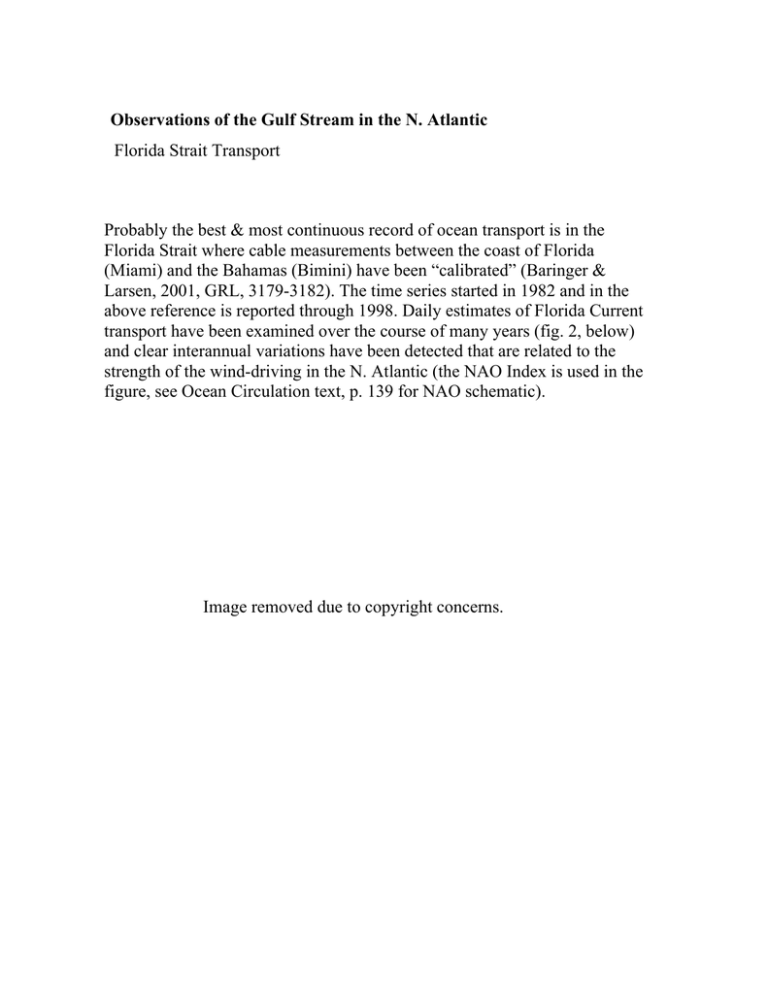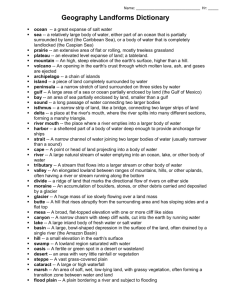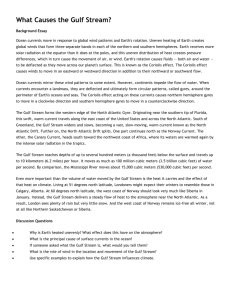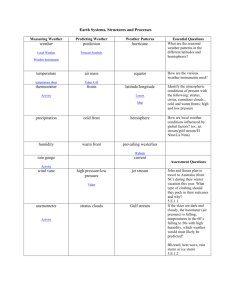Observations of the Gulf Stream in the N. Atlantic
advertisement

Observations of the Gulf Stream in the N. Atlantic Florida Strait Transport Probably the best & most continuous record of ocean transport is in the Florida Strait where cable measurements between the coast of Florida (Miami) and the Bahamas (Bimini) have been “calibrated” (Baringer & Larsen, 2001, GRL, 3179-3182). The time series started in 1982 and in the above reference is reported through 1998. Daily estimates of Florida Current transport have been examined over the course of many years (fig. 2, below) and clear interannual variations have been detected that are related to the strength of the wind-driving in the N. Atlantic (the NAO Index is used in the figure, see Ocean Circulation text, p. 139 for NAO schematic). Image removed due to copyright concerns. This transport is one main “benchmark” against which all numerical models of the ocean can be judged: do they get the transport correct or not? Do they get the same temporal variability? Do they get the correct seasonal cycle? The transport is seen to vary seasonally (see fig. 3, above reference, below) Image removed due to copyright concerns. There is a suggestion of a different annual cycle in the first half of the record compared to the second half. The range of the annual cycle (2-3 Sv.) is about the same as the range of interannual changes. The mean value (32.2 Sv.) is somewhat larger than we would expect from the Sverdrup transport at this latitude (26N, homework problem). The discrepancy can in part be related to the fact that some water flowing thru Florida Strait is from the South Atlantic and is required by the thermohaline circulation, which we will discuss in a later part of the course. The failure of the mid-latitude Sverdrup balance is more apparent as Cape Hatteras is approached, as shown in another “classic” study. The transport measurements in the Florida Strait have been made with “cable” voltages, since the Lorentz force of a charged particle moving thru the earth’s magnetic field will be a right angles to the magnetic field. An upward component of the magnetic field will deflect positive ions to the right of the flow and negative ions to the left, making for a potential difference across the flow, which can be measured using submarine telephone cables (not used anymore!). Some corrections need to be made for the electrical resistivity of the ocean bottom, but once made, cable measurements provide the most continuous measure of water transport in the ocean. Cape Hatteras transport of the Gulf Stream Halkin and Rossby (1985, JPO, 1439-1452) made 16 repeated sections between Sept. 1980 and May 1983 across the Gulf Stream just as it left the coast at Cape Hatteras. They used an instrument (Pegasus) which was essentially an acoustically-tracked probe which measured temperature and pressure and whose tracking yielded horizontal velocity. At some pre-set depth, the instrument releases a weight and returns to the ocean surface where it is recovered and re-deployed by a ship at another site. The work shows several things: the importance of streamwise averaging, the total volume transport of the upper 2000m, and the inflow into the Gulf Stream which increases its transport downstream. The figure below shows the streamwise averaging scheme schematically (we will discuss it in class). Image removed due to copyright concerns. A streamwise coordinate system was used to simulate the Gulf Stream structure irrespective of the angle of the current to the section and irrespective of the location of the velocity maximum at different locations along the section. The measured mean velocities and temperatures are shown in the next figure followed by a plot of the mean properties in a streamwise coordinate system. Images removed due to copyright concerns. Streamwise averaging makes for a sharper flow (compare the middle panels of the above two figures) and for an interesting result from the flow at right angles to the section (lower right panel), which now shows inflow into the Gulf Stream from both sides, amounting to a downstream increase of transport of about 15 Sv. per 100 km of distance downstream. The total transport of the flow in the upper 2000m is approximately 88 Sv and 94 Sv for the whole water column. We can see that this transport far exceeds the expected Sverdrup return flow and transport in the Florida Straits. Inflow from either side of the Gulf Stream is a consequence of two counter-rotating gyres on either side of the current. These are called re-circulation gyres as flow is confined to regions on both the north and south sides of the Gulf Stream. Before we get to these, another “long” timeseries of Gulf Stream flow was made at 68W, further downstream from Hatteras section above (at 73W), this time using moored instrumentation, not probes dropped from research vessels. Data were examined in a similar manner (defining a streamwise coordinate system) and the results published by Johns et al. (1995, JGR, C1, 817-838). Over two years of records were obtained between June 1988 and August 1990. An amazing figure (see their fig. 9) shows that the structure seen at Hatteras is reproduced further downstream with the width of the current similar at both locations (160 km). However, the maximum surface flow has increased and the depth extent of the current increases and is seen all the way to the ocean bottom (>4000m). The total transport at this 68W section was 113 Sv, approximately 20 Sv. larger than at 73W. Further downstream (between 60-65W) the Gulf Stream reaches its maximum transport of about 150 Sv. and then starts to decrease transport. The flows feeding this transport change are not wind-driven but a non-linear phenomenon, due to the fact that the Rossby Number becomes significant in the Gulf Stream and both steady and time-dependent flows can contribute to the circulation; these lie outside the simple dynamics we have considered thus far. The presence of strong eddies in the region is one mechanism for making the mean flow larger. In fact much of the transport structure shown by schematically by Hogg (1992, Deep-Sea Research, 39, 1231-1246) might be considered to be eddy-driven. Image removed due to copyright concerns. In the above figure (taken from Hogg), these two re-circulation gyres are shown on either side of the Gulf Stream. To the north, the Northern ReCirculation Gyre (NRG) is confined by the topography to lie between the Slope Water northeast of Cape Hatteras to the tail of the Grand Banks. To the south of the Stream, a Southern Re-Circulation Gyre (SRG) often ascribed to Val Worthington (Worthington Gyre or WG) is less confined but situated in the northern Sargasso Sea. The NRG circulates in a counterclockwise direction and the SRG rotates clockwise. These gyres have a strong barotropic as well as baroclinic signature: they extend from the surface to the ocean bottom. Although best defined in the N. Atlantic, they are present, with some variation, near strong western boundary currents in all the ocean basins and their existence has been linked to strong eddy motions which act to generate them. In this instance, eddies can act not only to dampen mean currents, but also force them! One important type of eddy found in the region of the Gulf Stream is a Gulf Stream ring, called that because a ring of Gulf Stream flow forms a meander which pinches off into large eddies on either side of the flow. Typically, 4-6 of these are formed each year in the region of the Gulf Stream and they can persist for months to in excess of a year. Those found to the north of the Stream (warm core rings) have shorter lifetimes than the cold core rings to the south.







